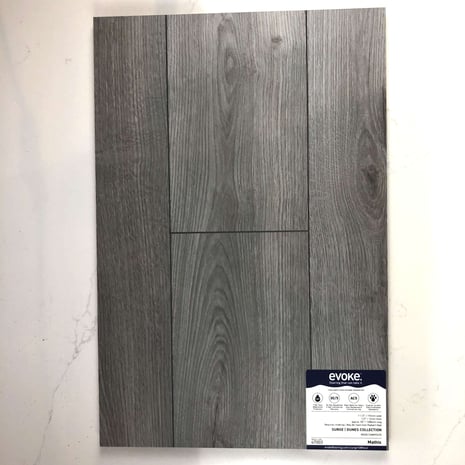These days, you have a wide range of vinyl and laminate flooring options to choose from. That can make picking the right one a daunting task. In this post, we break down the differences between vinyl vs laminate flooring based on 5 key categories, so you can confidently select the best material for your home.
Both LVP, or Luxury Vinyl Plank, and laminate flooring are popular alternatives to natural hardwoods when it comes to home remodels or for those simply looking to upgrade some of their existing floors. So how do you know which is the better choice for your home? Let’s look at vinyl vs laminate for the following 5 categories:
- Durability
- Water resistance
- Aesthetic
- Price
- Environmental impact
Quick Answer: It Depends on Your Room
Best for Kitchens & Bathrooms: Vinyl OR Premium Waterproof Laminate
Best for Living Rooms & Bedrooms: Laminate
Best for Basements: Vinyl
Most Budget-Friendly: Laminate
Most Realistic Wood Look: Laminate
The Simple Breakdown
| Vinyl | Laminate | |
|---|---|---|
| Looks like real wood | Good | Better |
| Handles water spills | Excellent | Good to Excellent* |
| Resists scratches | Good | Better |
| Cost | More expensive | Less expensive |
| Easy to clean | Easier | Easy |
| Comfortable underfoot | Softer | Firmer |
*Premium waterproof laminate only
What's the Difference?
Vinyl Flooring (LVP)
- Made from: 100% plastic/vinyl
- Best feature: Completely waterproof
- Looks like: Wood (pretty good)
- Feels like: Soft, slightly bouncy
- Price: $4-8 per sq ft
Laminate Flooring
- Made from: Wood core with protective layers
- Best feature: Looks most like real wood
- Looks like: Wood (very realistic)
- Feels like: Firm, like real hardwood
- Price: $3-6 per sq ft
Durability
Scratch Resistance
- Laminate: Hard to scratch, but if you do scratch it, it's hard to fix
- Vinyl: Easier to scratch, but easier to repair
Heavy Furniture
- Laminate: Won't dent from furniture legs
- Vinyl: May show dents from heavy furniture
Kids & Pets
- Both work well - laminate resists damage better, vinyl cleans up easier
Water Resistance: The Real Story
We tested 5 different floors with 24 hours of standing water. Here's what happened:
Vinyl Results
Zero damage - can handle floods, spills, anything
100% waterproof throughout
Safe for any room including bathrooms
Laminate Results
Budget laminate: Swelled up, stayed warped
Mid-range laminate: Some swelling, mostly recovered
Premium waterproof laminate: Zero damage (just like vinyl)
The Bottom Line: Vinyl is always safe around water. With laminate, you need to spend more for waterproof versions.
Room-by-Room Guide
Kitchen
Best Choice: Vinyl OR Premium Waterproof Laminate
Why: Kitchens have spills, dishwasher leaks, and heavy traffic. Both options handle water and resist scratches from dropped items.
Avoid: Cheap laminate (will swell if water gets underneath)
Living Room & Bedrooms
Best Choice: Laminate
Why: These rooms rarely see water, so you can focus on appearance. Laminate looks more like real hardwood and feels more natural underfoot.
Bathrooms
Best Choice: Vinyl OR Premium Waterproof Laminate
Why: Bathrooms need 100% waterproof flooring. Regular laminate will fail here.
Critical: Only use laminate specifically labeled "100% waterproof core"
Basement
Best Choice: Vinyl
Why: Basements can have humidity and moisture issues. Vinyl handles these better than any laminate.
Cost Comparison
| Project Size | Vinyl Cost | Laminate Cost | Savings with Laminate |
|---|---|---|---|
| Small room (100 sq ft) | $500-800 | $300-600 | $200-300 |
| Kitchen (200 sq ft) | $1,000-1,600 | $600-1,200 | $400-600 |
| Whole house (1,500 sq ft) | $7,500-12,000 | $4,500-9,000 | $3,000+ |
How They Look & Feel
Appearance Winner: Laminate
Why laminate looks better:
- Print matches the texture (knots look raised where they should)
- More realistic wood grain patterns
- Better color variation between planks
- Often mistaken for real engineered hardwood
Comfort Winner: Vinyl
Why vinyl feels better:
- Softer underfoot (better for standing long periods)
- Warmer surface temperature
- Quieter when walking


Installation: What to Expect
Both Are DIY-Friendly
- Click-together planks that snap into place
- No glue or nails needed
- Weekend project for most rooms
Professional Installation Costs
- Vinyl: $2-4 per sq ft
- Laminate: $2-3 per sq ft
Why Hire Professionals
- Subfloor preparation (critical for long-term performance)
- Moisture barriers (especially important in basements)
- Warranty protection on installation
Maintenance: Daily Reality
Vinyl Maintenance
Wet mop anytime - completely waterproof
Steam clean safe
Spills don't matter - clean when convenient
Pet accidents no problem
Laminate Maintenance
Damp mop only - too much water can cause problems
No steam cleaning
Clean spills quickly (especially on cheaper laminate)
Easy daily cleaning with vacuum or sweep
Environmental Impact
Laminate Wins (Usually)
- Made from wood (renewable resource)
- Better for recycling
- Lower manufacturing impact
But check: Make sure the wood comes from sustainable forests
Vinyl Impact
- Made from petroleum (non-renewable)
- Harder to recycle
- But: Vinyl flooring is a tiny fraction of global plastic use
Final Recommendation
For most homeowners doing a remodel: Start with laminate in living areas (better look, lower cost) and vinyl in wet areas (kitchens, bathrooms, basements). This gives you the best of both worlds.
For whole-house projects: If you want one floor throughout, vinyl is the safest choice - it works well everywhere and eliminates any water damage risk.
For budget-conscious projects: Quality laminate in dry areas offers the best value, but don't cheap out in kitchens and bathrooms.
Remember: Both vinyl and laminate are excellent "better" level flooring options. Your choice depends more on your specific rooms and priorities than finding an overall "winner."
Ready to choose the perfect flooring? Our design-build team can help you evaluate your specific needs and see samples that would work beautifully in your home.



